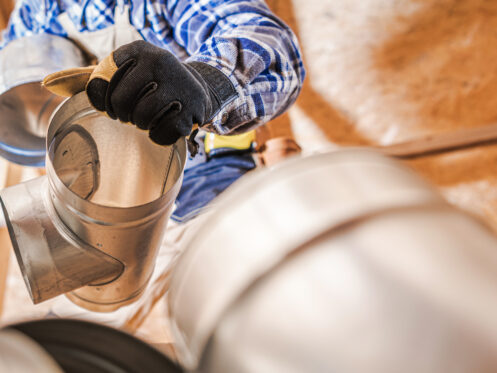Ductwork is one of the most important parts of an HVAC system. You can essentially think of your ductwork as your home’s lungs since it is responsible for pulling warmer or cooler air in and then blowing the heated or cooled air back out throughout the house. Ductwork is also typically the most neglected part of an HVAC system since most people just focus on their furnace and air conditioner. Here, we’ll explain the different parts of a ductwork system and why your ducts are so important for your comfort.
Parts of a Ductwork System
The ductwork system in a central heating and air conditioning system consists of several different parts. The part of the system that supplies hot and cold air to each part of the home is known as the supply ductwork. The supply ductwork connects to the large sheet metal supply plenum, which in turn connects to the air handler. This is where both the blower or fan and the AC evaporator coil are located. The main part of the supply ductwork is known as the trunk duct. Smaller sections of ductwork known as branch ducts connect to the trunk. Each of the branch ducts then connects to one or more supply vents where the hot and cold air blow out of.
The other main part of the system is the return air ductwork, which is where air is drawn into the system so that it can be heated or cooled. The return duct connects to the return air plenum on one end. This plenum connects to the furnace and air handler and is usually where the air filter is located. At the other end of the return ductwork are the return vents. Many older homes have only one larger return vent that is located just above the floor on a wall in the main hallway or another central part of the house. Newer homes or houses where the HVAC system is in the attic typically have return vents in the ceilings. Sometimes there are also additional vents near the floor. In systems that have return air vents in the ceilings, sometimes there is an air filter located just behind the vent cover.
Types of Ductwork
The ductwork in most homes is made out of rigid sheet metal. The return duct and the supply trunk duct are usually quite large and rectangular. The supply branch ducts are quite a bit smaller than the trunk and can be either rectangular or cylindrical.
Some systems instead use flexible ductwork for some of the branch ducts, especially in confined spaces where there isn’t sufficient room to install sheet metal ducts. While flexible ductwork is a good option in these situations, it isn’t very durable. This is because flexible ductwork is essentially just two pieces of plastic with foil on the outside, and it is extremely easy for holes to get poked through the plastic.
There are also systems that use either rigid fiberboard or fiberglass ducts instead of sheet metal. Fiberboard is great at retaining heat, which is why it is often used in colder climates. The issue is that the inside of the ducts are textured, which means that they trap lots of dirt and debris and need to be cleaned much more often. Fiberglass ductwork is most commonly used in commercial HVAC systems since it is much better at reducing noise. It is also better at insulating than sheet metal. The issue with this type of ductwork is that it starts to release small particles of fiberglass as it ages and deteriorates, which can be harmful to breathe in.
The Importance of Properly Designed and Installed Ductwork
For a heating and air conditioning system to work effectively and efficiently, all of the ductwork must be properly designed and installed. The size of all of the ducts is especially important for a few different reasons. An HVAC system needs to constantly pull in and put out the same amount of air. There are many more parts to the supply ductwork. This means that the return duct needs to be quite a bit bigger so that there is sufficient airflow to the entire supply part of the system.
Your HVAC system also needs to move a certain volume of air, measured in cubic feet per minute (CFM), for it to work effectively. Exactly how many CFM the system needs to circulate depends on the size of the furnace and air conditioner or heat pump.
Undersized ductwork tends to make an HVAC system much noisier since the air moving through the ducts is under more pressure. If the ducts are too small, it also puts additional strain on the blower and makes it work much harder. This usually leads to the blower having a much shorter lifespan.
If the ducts are too large, the blower won’t be able to effectively circulate a sufficient volume of air. This means that your heating and air conditioning will be much less effective, which overworks your HVAC system and will typically shorten its lifespan. It will also lead to your energy bills being much higher and your system likely needing many more repairs.
When designing a ductwork system, technicians always attempt to run as much of it in a straight line with as few bends and turns as possible. Having too many turns and bends also makes it much more difficult for the blower to move sufficient air through the ducts. This will again lessen the effectiveness of your heating and AC.
How Old or Damaged Ductwork Affects Your HVAC System
Most ductwork systems will last for around 25 to 30 years. If your ductwork is old or it is damaged and leaks, it will also greatly decrease the efficiency and effectiveness of your heating and AC. In fact, leaky ducts can often lead to your energy bills being 20-30% higher than they should be. As ductwork ages, it sometimes starts to sag to where the different sections are no longer tightly connected. The foil tape or mastic used to seal between the different sections also degrades over time or can come loose.
Any leaks will allow lots of air to escape. If the return ductwork is leaky, the system won’t be able to pull in sufficient air. Leaky supply ducts lead to much less air flowing out of the vents they supply, which usually leads to hot or cold spots in the home. These issues are why you should have your ductwork inspected at least once every few years and fully resealed every 10 years or so.
How Static Pressure Affects Airflow
Static pressure is the measure of how much airflow resistance there is in a duct system. Ideally, the static pressure in an HVAC system will be fairly low. Unfortunately, many homes have various issues that lead to the static pressure being quite a bit higher than it should be. When the static pressure is higher than it should be, it makes it much harder for the blower to circulate sufficient air and thus limits the system’s effectiveness. This is simply because the air meets more resistance as it flows through the ducts.
Some of the common causes of high static pressure are a dirty air filter or using a filter that is too efficient and restricts airflow. Undersized return ductwork also leads to high static pressure as can dirty ductwork. These issues are why it’s important that you use the right filter and replace it regularly. Having your ductwork professionally cleaned every three to five years is also important for preventing issues with high static pressure.
The Professionals You Can Trust
Marr's Heating and Air Conditioning is a family-owned HVAC company that has been serving the Bellingham area since 1965. We specialize in ductwork design and installation as well as duct sealing and cleaning. We’re also the top choice if you need any other heating, air conditioning or indoor air quality service. Contact us today if you need to have your ductwork inspected or to schedule any other service.

